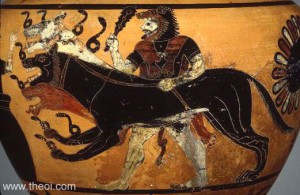Dogs are important to all three aspects of Diana as the goddess of the hunt, the moon, and the underworld.

Dogs were vital for a successful hunt in antiquity. They tracked prey by their scent and drove them towards the traps set by their masters. Because of their importance, the sanctuary at Aricia offered advice on the care of hunting hounds, pregnant dogs, and their pups. 1
As Green explains, “This is entirely consistent with her identity as goddess of the moon – who governs the growth of plants and animals and the physical changes that either heal or harm the body – and as a hunting deity. Hunting cults were always repositories of knowledge about plants and animals, the care of the young, and both the giving and healing of wounds.” 2
Of course, one of the most famous dogs in Classical mythology is Cerberus, the three-headed dog who guarded the entrance to the Underworld.

hydria, 6th BCE, Musée du Louvre.
